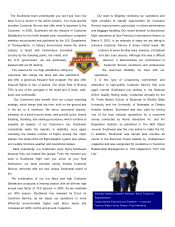Southwest Airlines 2000 Annual Report Download - page 21
Download and view the complete annual report
Please find page 21 of the 2000 Southwest Airlines annual report below. You can navigate through the pages in the report by either clicking on the pages listed below, or by using the keyword search tool below to find specific information within the annual report.
satisfy the strong demand for scheduled service and,
therefore, make fewer aircraft available for charters.
OPERATING EXPENSES Consolidated operating
expenses for 2000 increased 17.1 percent, compared to the
13.3 percent increase in capacity. Operating expenses per
ASM increased 3.3 percent to $.0773, compared to $.0748 in
1999, primarily due to an increase in average jet fuel prices.
The average fuel cost per gallon in 2000 was $.7869, which
was the highest annual average fuel cost per gallon
experienced by the Company since 1984. Excluding fuel
expense, operating expenses per ASM decreased 2.6
percent.
Operating expenses per ASM for 2000 and 1999 were as
follows:
OPERATING EXPENSES PER ASM
2000 1999 Increase
(Decrease)
Percent
Change
Salaries, wages, and
benefits 2.41¢ 2.39¢ .02¢ .8%
Employee retirement
plans .40 .36 .04 11.1
Fuel and oil 1.34 .93 .41 44.1
Maintenance materials
and repairs .63 .70 (.07) (10.0)
Agency commissions .27 .30 (.03) (10.0)
Aircraft rentals .33 .38 (.05) (13.2)
Landing fees and other
rentals .44 .46 (.02) (4.3)
Depreciation .47 .47 – –
Other 1.44 1.49 (.05) (3.4)
Total
7.73¢ 7.48¢ .25¢ 3.3%
Salaries, wages, and benefits per ASM increased slightly,
as increases in productivity in several of the Company’s
operational areas were more than offset by higher benefits
costs, primarily workers’ compensation expense, and
increases in average wage rates within certain workgroups.
The Company’s Ramp, Operations, and Provisioning
Agents are subject to an agreement with the Transport
Workers Union of America (TWU), which became amendable
in December 1999. Southwest is currently in negotiations
with TWU for a new contract. The Company’s Mechanics are
subject to an agreement with the International Brotherhood of
Teamsters (the Teamsters), which becomes amendable in
August 2001.
Employee retirement plans expense per ASM increased
11.1 percent, primarily due to the increase in Company
earnings available for profitsharing.
Fuel and oil expense per ASM increased 44.1 percent,
primarily due to a 49.3 percent increase in the average jet
fuel cost per gallon. The average price per gallon of jet fuel in
2000 was $.7869 compared to $.5271 in 1999, including the
effects of hedging activities. The Company’s 2000 and 1999
average jet fuel prices are net of approximately $113.5
million and $14.8 million in gains from hedging activities,
respectively. As detailed in Note 7 to the Consolidated
Financial Statements, the Company has hedges in place for
the majority of its anticipated fuel consumption in 2001 at
prices below market prices as of December 31, 2000.
Including estimated hedging gains and considering current
market prices and the anticipated impact of the adoption of
Statement of Financial Accounting Standards No. 133 (SFAS
133) (see Recent Accounting Developments in Note 1 to the
Consolidated Financial Statements), we are forecasting our
first quarter 2001 average fuel price per gallon to be no
higher than first quarter 2000’s average price per gallon of
$.82. (The immediately preceding sentence is a forward-
looking statement, which involves uncertainties that could
result in actual results differing materially from expected
results. Such uncertainties include, but may not be limited to,
the largely unpredictable levels of jet fuel prices and the
effectiveness of the Company’s hedges.)
Maintenance materials and repairs per ASM decreased
10.0 percent primarily because of a decrease in engine
maintenance expense for the Company’s 737-200 aircraft
fleet as 1999 was an unusually high period for engine
maintenance on these aircraft. The -200 engine repairs are
expensed on a time and materials basis. These engine
repairs represented approximately 75 percent of the total
decrease, while a decrease in airframe inspections and
repairs per ASM represented the majority of the remaining
total decrease. The decrease in airframe inspections and
repairs was primarily due to a greater amount of this work
being performed internally versus 1999, when a large portion
of this type of work was outsourced. Therefore, in 2000, a
larger portion of the cost of these repairs is reflected in
salaries and wages. Currently, we do not expect a significant
increase in unit cost for maintenance materials and repairs in
first quarter 2001 versus first quarter 2000. (The immediately
preceding sentence is a forward-looking statement involving
uncertainties that could result in actual results differing
materially from expected results. Such uncertainties include,
but may not be limited to, any unscheduled required aircraft
airframe or engine repairs and regulatory requirements.)
F3
























